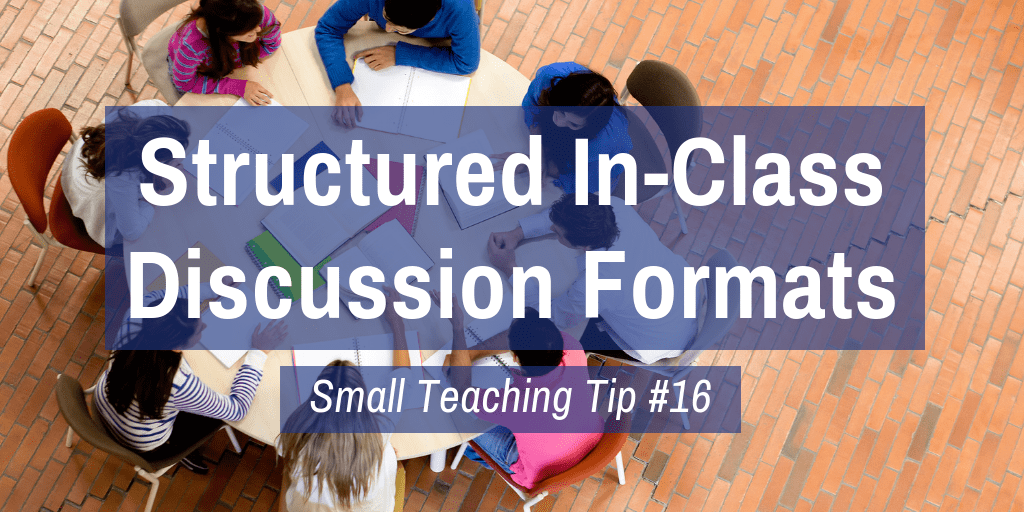“I’m tired of looking out at a sea of blank faces.”
“There’s nothing but crickets when I try to get a discussion going.”
“It’s like talking to a brick wall!”
How many times have you lamented the quality of discussions in your classes? Facilitating engaging conversations is one of the most challenging aspects of teaching. Even the most brilliant lecturer can be stymied by an unresponsive class.
Often, class discussions fall flat because we fail to remember that students are academic novices. They are not subject matter experts and they are unfamiliar with academic discourse. When it comes to in-class discussions, students benefit from clearly stated instructions, explicit expectations, and structure. Here are a few popular structured discussion formats to try:
Think-pair-share
After lecturing, ask students to jot down their responses to a prompt you provide on scrap pieces of paper or in a Google Doc. After a few minutes, ask them to turn to their neighbors and share their ideas. Finally, bring the entire class together and have the pairs report what they discussed and use what arises as a jumping off point for an entire class discussion. This simple exercise gives students the chance to think and talk through their ideas before being put “on the spot” in front of the entire group. This is essential for students who struggle to participate in discussions because of introversion, social anxiety, or learning disabilities.
Fishbowl
In this exercise, instructors seat students in two concentric circles. The inner group of students discuss a topic while the outer group listens and take notes. Then, the groups switch roles and the outer group summarizes the inner group’s ideas and builds on them. This discussion format helps students practice active listening and argumentation. Another version of the fishbowl is problem-based, in which the central group is charged with solving a problem and the outer group listens and acts as researchers and advisors.
Gallery walk
Place large sheets of paper around the room each with a different prompt (e.g. question, problem, brainstorming task). Assign a few students to each sheet of paper. Give the groups 5 minutes to respond to the prompt. The groups then rotate to a new sheet and build upon the previous group’s comments. After all the groups visit each sheet, everyone walks around the “gallery” to read all the responses. This can then serve as a springboard for a larger class discussion about conclusions and questions that arose.
Stand where you stand
This exercise works for discussions about questions that don’t have a single answer and, thus, can be debated. Assign a different theoretical or analytical perspective to each corner of the classroom. Ask students to stand in the corner of the room that represents their position on the issue. As a small group, they should formulate evidence-based arguments to support their position that they think will convince others to agree with them. Each group then presents their arguments and students are given the opportunity to move to a different corner if they were convinced to change their mind. Students can articulate why the arguments did or did not change their opinion on the topic, which can lead to a discussion of effective argumentation and persuasion.
Jigsaw
This exercise is a great use of peer teaching. In preparation for class, each member of a small group completes a different reading on a particular topic (that they find themselves or that the instructor assigns). In class, each student shares a summary of their reading and his/her analysis with their team. During this “reporting out” and subsequent discussion, students become budding “experts” on a specific topic. After a period of time, each student then moves to a new group to teach their speciality to their classmates.
Instructors can also incorporate other sources of knowledge, such as student’s own experiences. For example, students could analyze how a recent experience aligns with or deviates from the theoretical perspective they examined or the results of the research they read. Students could also complete a “webquest” by seeking examples online (e.g. memes, cartoons, quotes, video clips) and using them to supplement their small group discussion.
Collaborative autoethnography
Based on the qualitative research method designed by Heewon Chang, this exercise privileges students’ lived experiences and encourages significant self-reflection. Students use both their own stories and scholarly sources to analyze a larger societal context. This exercise could take multiple class periods, or could even become the overarching structure of a course. It involves 6 stages:
- Students collectively explore a particular phenomenon, problem, or question as a small research team. Based on research and their personal stories related to the phenomenon, students generate an initial set of questions to explore further.
- Students then individually reflect on these questions and write their own responses.
- They then share their reflections with their team, which collectively identifies commonalities, differences, and remaining questions.
- Those themes and questions are discussed in class, benefiting from the insights of classmates and instructor. What arises from those conversations becomes the next set of prompts for further research by the team.
- This cycle of researching, reflecting, and sharing is repeated until no new discoveries occur (or the time allotted for the exercise runs out)
- The team then writes about their overall findings, often building models to explain the phenomenon explored.
These ideas are great for face-to-face classes and, with the help of technology and some creative thinking, a few could also be adapted for online courses. I also recommend the book Creating Engaging Discussions: Strategies for Avoiding Crickets in Any Size Classroom and Online by Jennifer Herman and Linda Nilson. And for more help improving discussions, check out these posts:
Do you have other suggestions for facilitating engaging class discussions? Please share!

